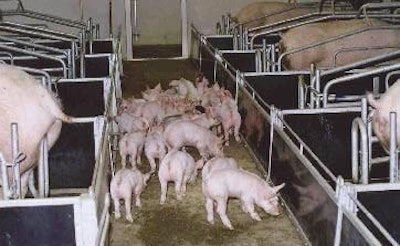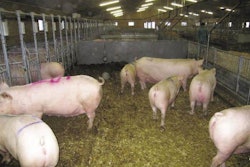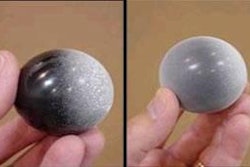
Questions are often raised about sow longevity, with the suggestion that animals are removed or replaced too early for herd productivity. The other side of the argument has surfaced at a meeting in Denmark. There is a danger, said speakers, that sows can be kept in production too long — when the better course of action would have been to bring in new gilts.
Managing parity distribution of the breeding herd
The discussion about managing the parity distribution of the breeding herd featured when international visitors gathered for the Danish symposium arranged by DanBred. The meeting was reminded that although genetic improvement continues to give a significant lift to sow productivity, the outcome in terms of results is influenced by parity number. The most mature sows in the herd not only cost more to maintain, they are likely to give a higher mortality rate among piglets.
Michael Groes Christiansen from national development agency Dansk Svineproduktion (DSP) told the symposium about observations made at five Danish herds which demonstrated that their number of piglets born alive per litter increased at each farrowing only until Parity 3 or 4. After that, the pattern was for litter size to level off or even decrease (Figure 1).
Previously unpublished results from the same investigation can be seen in Table 1. These related to litters that had been standardised shortly after birth to give 12 piglets per sow. They were weaned at between 21-28 days old. Clearly, even sows in the third or fourth parity were starting to be less productive than younger mothers, as more of their baby pigs died and fewer were weaned. The mortality rate and number weaned declined steadily afterwards, with a particular rise in losses around Parity 6.
The ability of the sow to take care of suckling piglets decreases with age, Mr Groes Christiansen declared. The reasons for the association between extra piglet mortality and parity number (Table 2) may be simply a matter of her size and clumsiness. Damaged teats and legs could be contributory factors in the older animal. Whatever the explanation, the general tendency is clear. More baby pigs die with each increase in the parity number of the sow.
Parity distribution can be uneven. An analysis of herd records found that about 80% of the sows on these units were likely to stay to have an additional farrowing at least until they were at Parity 4. After being weaned from the Parity-4 litter, however, their chances of remaining dropped to 70%. Generally in Denmark, most herds were reported to have adopted a strategy of replacing sows after Parity 6. One influence in this decision has been that Danish measurements have shown Parities 4, 5 and 6 to comprise the period during which the sows yield most milk. Moreover, of course, the weight gained by the sow at successive parities leads to an increase in her cost of maintenance.

















